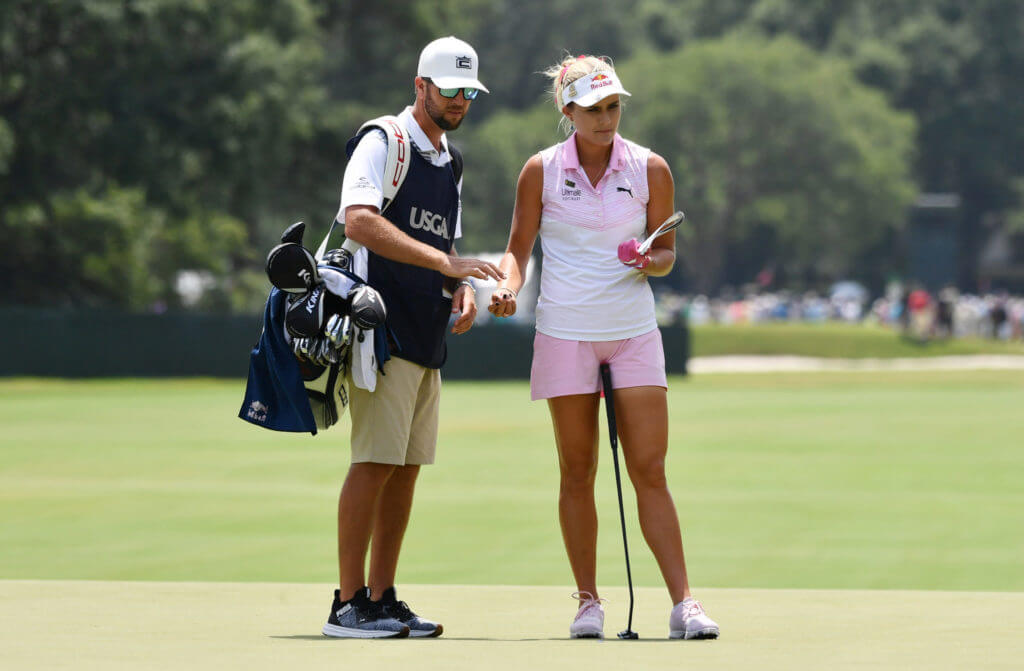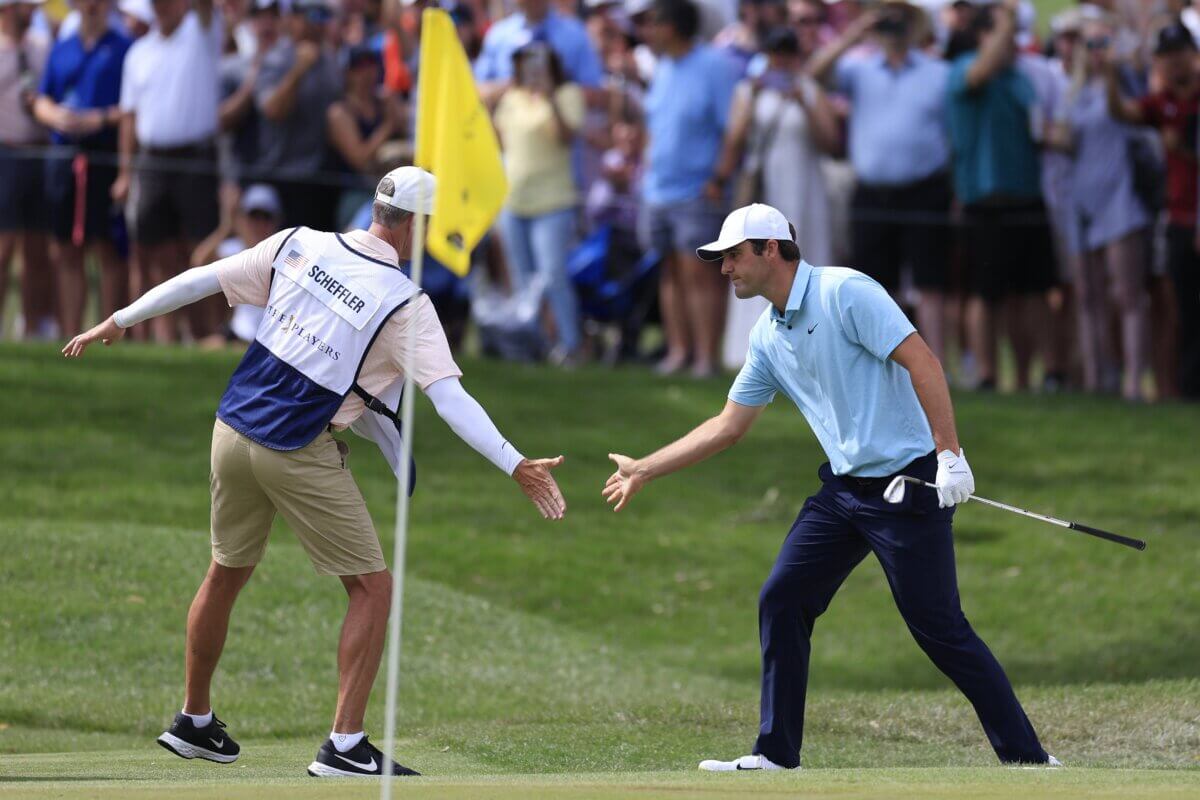Caddie Picks: 2019 KPMG Women’s PGA Championship

The KPMG Women’s PGA Championship – the third major of the LPGA season – takes place this week at Hazeltine National in Chaska, Minn.
That’s the same Hazeltine that played host to the last U.S. Ryder Cup victory in 2016.
Here’s a dispatch, along with tournament predictions, sent into us by a veteran LPGA caddie (who will remain anonymous to protect the caddie’s identity), looping this week in the tournament:
When I first got the yardage book for the 2019 KPMG Women’s PGA Championship at famed Hazeltine National Golf Club, I jokingly asked if this was accidentally the one from the 2016 Ryder Cup.
Actually, I wasn’t really joking because at first glance of the book, I saw:
- Hole 1: 417, Par 4
- Hole 3: 568, Par 5
- Hole 5: 400, Par 4
- Hole 7: 514, Par 5
- Hole 9: 396, Par 4
- Hole 10: 408, Par 4
- Hole 11: 560, Par 5
- Hole 12: 429, Par 4
- Hole 13: 204, Par 3
- Hole 15: 541, Par 5
- Hole 18: 416, Par 4
If you add up the yardage book from the tips, you got 6,850 yards. To put that in perspective, we just watched the men’s U.S. Open at 7,000 yards.
Upon analyzing, six of the 10 par 4s this week are 400+ yards and three of the four par 5s are longer than than the men last week at Pebble Beach. And the one that’s shorter is only shorter by nine yards. The longest men’s par 5 last week was only 20 yards longer than the longest women’s par 5 this week.
Add this to the fact that the men carry it, on average, 50 yards off the tee longer than the women and 30 yards more with their irons, you can see me joking about this yardage book being for the men.
Also, what needs to be mentioned, is while the fairways have gotten firmer as the week has gone on, the course previously got a lot of rain and the temperatures are only expected to reach the 70s, with chances of rain, so driver carry will be important. There’s no telling how much roll players can expect.

But the greens are releasing, making the longer clubs tougher to hold. Thank God the rough is somewhat playable just off the fairway, but it’s gnarly around the greens.
Yes, I know rarely are courses setup from the tips and the PGA of America, who is in charge of course setup, has indicated that tees such as 7, 12, 13, and 15 could be moved up. However, this usually happens on the weekend, so expect the course to play extremely long for the majority of players the first two rounds.
A credit to the LPGA players that they are so good with their hybrids and fairway woods that they usually perform well enough to justify the setup, but it just boggles my mind what goes into a setup such as this that starts at 6,850. But coming off the PGA Championship at Bethpage Black back in May, which was 7,459 from the tips for the men — another bomber’s delight — and played longer because of conditions, I guess I shouldn’t be too surprised by the setup this week.
All I can think of is the PGA of America doesn’t setup many courses for women, but we also face this many weeks on the LPGA — courses that are too long for the women, and thus are boring to watch… part of the reason, in my opinion, that women’s golf struggles to find an audience.
Case in point: the Saturday final round of the Augusta National Women’s Amateur (ANWA) on NBC earned the highest-overnight TV rating for a women’s golf tournament since the 2016 U.S. Women’s Open, according to data from The Nielsen Company, reported by NBC Sports.
The .96 rating also marked the most viewers of any amateur golf telecast – men’s or women’s – since the 2003 U.S Amateur men’s final.
Conversely, the ANA Inspiration, played simultaneously, saw a 56 percent drop in TV ratings for its Sunday final round on Golf Channel, according to Sports Media Watch, from 2018 (437,000 viewers) and 65 percent down from 2017 (551,000). On course attendance was also down about 10 percent from 2018, according to tournament director Chris Garrett.
Remember, the ANWA was an amateur event consisting of players that many of the viewing public had never heard of. But the attraction was Augusta National, which did a masterful job of course setup (6,300 yards), letting the girls play the course like the men, as the winner, Jennifer Kupcho, eagled No. 13 with a hybrid and birdied No. 15 with a hybrid as well.
But with this week’s setup, if played from the tips, even the longest players won’t be able to reach at least three of the four par 5s. So, the viewers get to see the likes of Lexi Thompson and Brooke Henderson, some the longest players on tour, hit wedges, making for some scintillating TV.
The reason I discuss the above is not only is it frustrating for the women, who are trying to attract new fans — and I believe course setup can enhance the product — but because at the end of the day, the LPGA Tour, like the PGA Tour, is in the entertainment business, which the PGA Tour has embraced and gets. It allows a majority of its players to reach par 5s in two and drive some par 4s, because this is what fans want to see, other than maybe at the U.S. Open.
I also talk extensively about course setup above because it goes a long way in determining the favorites and non-favorites this week, as this week is mostly about power and brute strength.
To me, setting up a course to simply make it long is lazy and doesn’t necessarily identify the best golfer, as I believe about 25 percent of the field has a legitimate chance this week.
From Paul Tesori, caddie for Webb Simpson, on Twitter after the U.S. Open:
I can’t say enough about @PebbleBeachGolf 1st hole is 380. 3rd is 397. 8th is 428. 11th is 390. 15th is 397. 16th is 401. All 6 of these holes are over par this week. Length is not the answer. Doglegs, rough, hazards and small greens are.
— Paul Tesori (@PaulTesori) June 16, 2019
I don’t want to come off as saying the course is too hard, because other than the length of some holes, it’s very fair from playability of rough in fairway to everything else. I know it’s a major and should be tougher than most LPGA weeks.
What I’m trying to get across, which the men are also dealing with, is that length isn’t the only way to make courses difficult — especially when this week we have multiple tee options from which to choose and they still chose 6,850 as a starting point.
Some weeks we are handcuffed by the course as far as setup but this week we are not.
So there is a difference between being too long and too difficult. I didn’t say it was too difficult. I simply said it could be shorter to allow more of the field a chance to compete. There aren’t a lot of birdie opportunities so it would be nice to have some par 5s reachable to give us some more chances, as my biggest complaint was length of par 5s for female golfers and how far the average hits it.
I just talked to someone helping with the tournament today and she asked if there’s anything I needed. I joked that a shorter course would be nice.
And her response was but we want to see the women really play.
So seems not only are course setup people, but also the public, are of the opinion that length is answer.
With that said, here is my pick this week… which to me was easy, as I just looked at the driving stats and who of the longest players is playing the best coming in…
Pick to win: My money is on Lexi Thompson and I think the winning score will be 10 under. Her last three finishes are T2 US Open (-4); Win at ShopRite, eagling the last hole to win by one (-12); T2 Meijer (-20).
Lexi, upon the suggestion of her brother Curtis, changed to the claw at the U.S. Women’s Open, so her main weakness, putting, which keeps her from being world No. 1, is in good form.
Add that to the fact that she seems in a good place, mentally, and is back with Benji Thompson, PGA Tour caddie who she won her only major with, and she seems like a logical pick.
Oh yeah, she also averages 276 off the tee, so that might help a bit this week.
Others of note: Defending champ and world No. 4 Sung Hyun Park (280 yards driving distance average).
Nasa Hataoka, world No. 6, who lost to Park last year in a playoff (265 yards driving distance average).
Sleeper: My sleeper is rookie Maria Fassi, the two-time ANNIKA Award winner, given to the top college player (Arkansas) and 2019 NCAA Individual Champion. She also was runner-up to Kupcho at the ANWA.
In two tournaments as a professional, Fassi has already wrapped up her tour card, finishing T12 at the U.S. Women’s Open (-1) and T34 at ShopRite (-1).
She hits it 280 off the tee and has Gary Matthews on the bag, who caddied for Charl Schwartzel before Charl got injured. Gary has caddied at Hazeltine before for the men.
Others sleepers of note: Angel Yin (282 yards driving distance average), coming off a T2 at the Women’s U.S. Open (-4), is not only looking for her first major, but first LPGA win of any kind.
Sei Young Kim (267 yards driving distance average), world No. 11 and eight-time LPGA winner, is also looking for her first major after coming off a T16 at the U.S. Women’s Open (even). Kim has Paul Fusco on the bag, who has been a part of all eight of her wins. He also spent time on the PGA Tour with Paul Casey, Vijay Singh (who he won with) and Mark Brooks, even caddying for Brooks at Hazeltine in the past.
Who won’t win: Inbee Park. While I searched for my favorites from atop the driving distance stats, I picked my non-favorite from further down the list:
No. 10-ranked player in world, Inbee Park, three-time winner of this event (2013-2015), simply because she’s 129th on tour in driving distance (252 yards, average) and often considered the best putter on tour, she’s struggled this year (69th on tour, 30.14 putts per round).
Also, despite averaging 276 yards off the tee, I think it will be hard for world No. 5, Brooke Henderson, to win back-to-back weeks, as well as world No. 7 and U.S. Women’s Open champion, Jeongeun Lee6 (267 driving average), to win back-to-back majors.






